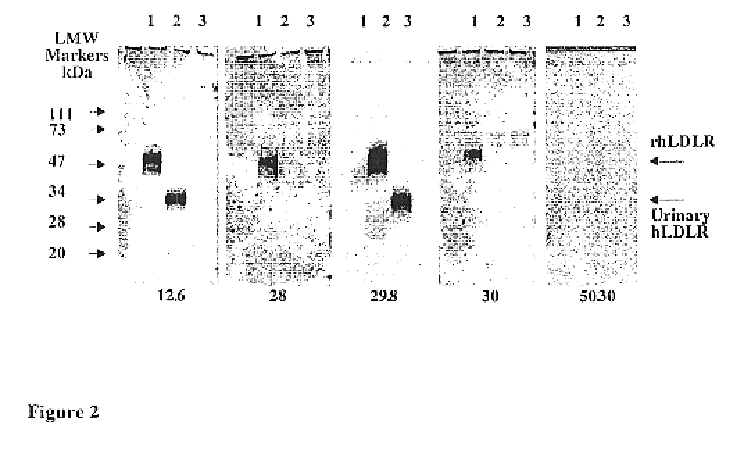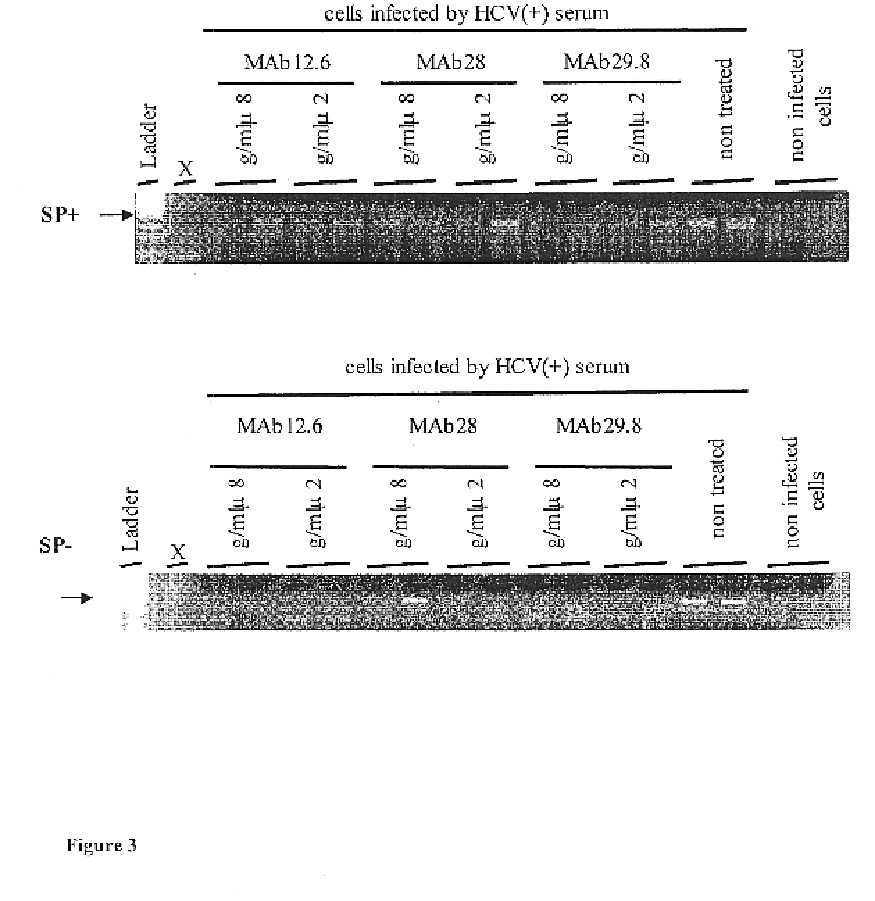Monoclonal antibodies to the human LDL receptor, their production and use
a human ldl receptor and monoclonal antibody technology, applied in the field of monoclonal antibodies, can solve the problems of low affinity to human, disease and death, and difficult to establish methods for identification and quantification of antigens during purification processes
- Summary
- Abstract
- Description
- Claims
- Application Information
AI Technical Summary
Benefits of technology
Problems solved by technology
Method used
Image
Examples
example 1
Preparation of CHO r-hsLDLR
[0070]Stable recombinant CHO cells expressing human soluble LDLR were generated by co-transfection of CHO-DUKX cells lacking the dihydrofolate reductase (DHFR) gene (Urlaub, G. et al., 1980) with two expression vectors: psLDLR01 containing the N-terminal ligand-binding domain of the LDLR, beginning at amino acid residue Asp (+4) up to Glu 291 (+291), and pDHFR, containing the murine gene for DHFR, both controlled by the promoter and transcription termination elements of the SV40 early region. Transfection was performed by cationic liposomes using LipofectAmine (Gibco BRL), according to the protocol described by the manufacturer. Seventy-two hours after transfection cells were transferred to a selective medium lacking deoxy and ribonucleosides and supplemented with 10% dialysed FCS. Cells expressing DHFR activity were able to form colonies, which were isolated by lifting the cells with trypsin-soaked paper discs The cells were grown and screened for r-hsLDL...
example 2
Immunization of Mice
[0073]b 10μg of the purified r-hsLDLR of fraction #27 of the SEC column of Example 1 above, at a concentration of 100 μg / ml, were homogenised with Complete Freund's Adjuvant (CFA, 50% v / v) and injected into the footpad of each of five 7 week old Balb / C female mice.
[0074]Four weeks after the first immunization, the mice were boosted, intramuscular with 10 μg of the same fraction of purified r-hsLDLR, in a 50% (v / v) solution of CFA.
[0075]Two weeks after the second injection the mice sera was tested for antibodies to r-hsLDLR, using the direct ELISA described in Example 3 below.
[0076]The two mice M-1 and M-2, with the most significant specific immunoreactivity with r-hsLDLR were further boosted, 10 weeks after the second injection, with 10 μg of the purified r-hsLDLR obtained in the refined purification process described in Example 1 above.
[0077]The mice were bled 14 weeks later and tested for antibodies to r-hsLDLR. They were then given two additional boosts of 50 ...
example 3
Direct ELISA for Antisera Testing and Hybridoma Clones Screening
[0080]The direct ELISA for screening for positive antisera was performed as following: 96 wells plates were coated with 100 μl of r-hsLDLR (purified by the refined purification process of example 1) 100 units / ml (10 U / well) in PBS+1% Gelatine (Sigma, Cat. No. G-7765)+0.9 mM Ca+2 and 0.5 mM Mg+2, pH 5.6, hereinafter referred to as assay buffer, for 90 min. at 37° C. with shaking. The plates were washed six times in PBS+0.05% Tween 20 (Polyoxyethylene-Sorbitan Monolaurate-Sigma P-1379), hereinafter referred to as wash solution.
[0081]Anti serum samples from the immunized mice serially diluted 1:100-1:32,000, or supernatant from hybridoma cell cultures were added to the wells and incubated for 90 min. at 37° C., while shaking, followed by six washes in wash solution.
[0082]100 μl of Horse Radish Peroxidase (HRP)-APA conjugated goat antibody to mouse Fab (Sigma—Cat. NO. 4601-1) diluted 1:1,200 were added to the wells and incu...
PUM
| Property | Measurement | Unit |
|---|---|---|
| concentration | aaaaa | aaaaa |
| pH | aaaaa | aaaaa |
| pH | aaaaa | aaaaa |
Abstract
Description
Claims
Application Information
 Login to View More
Login to View More - R&D
- Intellectual Property
- Life Sciences
- Materials
- Tech Scout
- Unparalleled Data Quality
- Higher Quality Content
- 60% Fewer Hallucinations
Browse by: Latest US Patents, China's latest patents, Technical Efficacy Thesaurus, Application Domain, Technology Topic, Popular Technical Reports.
© 2025 PatSnap. All rights reserved.Legal|Privacy policy|Modern Slavery Act Transparency Statement|Sitemap|About US| Contact US: help@patsnap.com



